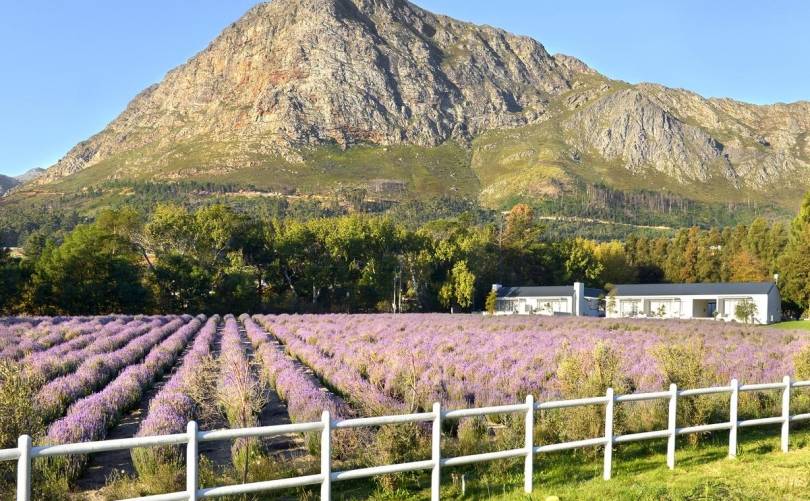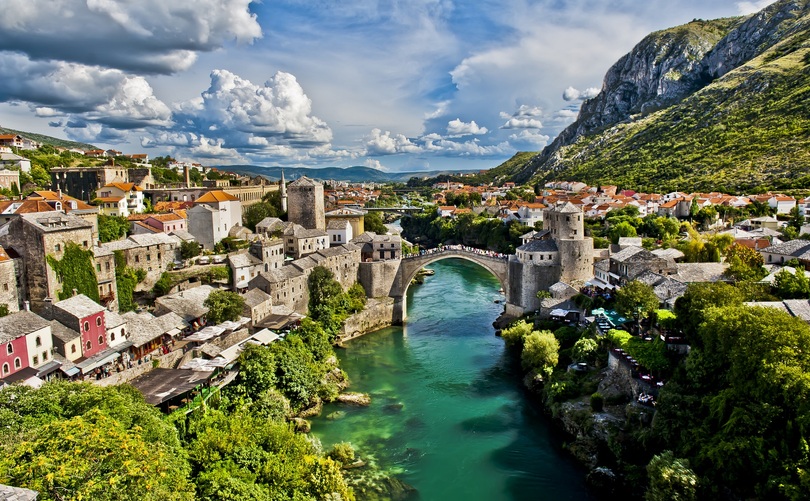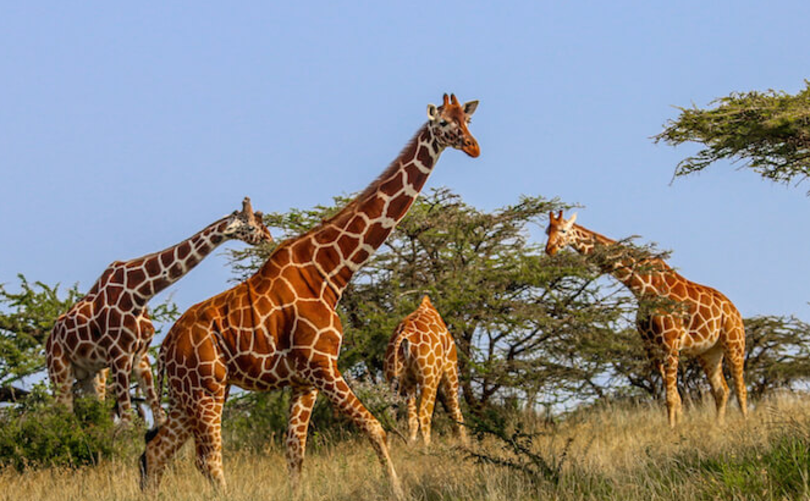
Highlights
- The Bimmah Sinkhole
- White Sands Beach
- Sur Dhow Factory
- Wadi Bani Khalid
- The Wahiba Sands
- Sinaw
- Nizwa
- Bahla
- Al-Jabal Al-Akhdar
- Tanuf
- Jabreen Castle
- Al-Hamra
- Misfat Al-Abriyeen
- Day 1 - Muscat - Bimmah Sinkhole - Fins White Sands Beach - Sur - Wadi Bani Khaldi - Wahiba Sands
- Day 2 - Wahiba Sands - Sinaw - Nizwa - Bahla - Birkat Al Mawz - Jabal Akhdar
- Day 3 - Tanuf - Jabreen - Misfat Al Abriyin - Al Hamra
- Additional Information
The Bimmah Sinkhole:
Recently mooted as the most beautiful sinkhole in the world, the cerulean waters of Bimmah Sinkhole attract thousands of visitors every year. It was created by the collapse of a soft limestone ceiling in an underground cavern which is rather less poetic than the Arabic name of ‘Meteor Fall Park’ suggests. The sinkhole is a beautiful natural phenomenon and a great place to stop for photos or a quick swim.
White Sands Beach:
A beautiful small stretch of beach with gleaming white sand and sapphire waters interrupts the rocky coastline not far from Wadis Shab and Tiwi. If you wish to venture into the water, the snorkeling is great but if you would simply like to stretch your legs this is a wonderful place for beachcombing.
Sur Dhow Factory:
The old town of Sur faces out to the sea from whence its fortunes came. As the capital of the Sharqiya region, it has an illustrious past as one of the most important ports in the region, a key point of trade with East Africa and India. The forts and watchtowers, which circle the town, give a hint at its past significance. Head to the harbor to find its main attraction, the traditional dhow building yard that still manufactures wooden boats as it has for hundreds of years. Oman is immensely proud of its maritime heritage and, although demand has decreased, Sur still makes boats for customers all over the world, which are proof of the quality of their workmanship. The yard is a laid back place which you may wander around at your leisure.
Wadi Bani Khalid:
Water flows all year round in this very beautiful and popular natural retreat. A zigzag drive up the mountainside will get you to the entrance of this long river bed populated with villages and fertile plantations. The water flowing from several springs collects in deep, clear pools that are made easily accessible by a series of paths and bridges. You may swim but remain respectful to the local people by staying well covered. As long as the water levels are not too high you can explore further into the undeveloped parts of the wadi and, not for the faint hearted, take some sturdy walking shoes and a torch and seek out the Moqal Cave.
Be Mesmerised by The Wahiba Sands:
trip into the Wahiba (or Sharqiya) Sands is the perfect way to get taste of storybook Arabian desert. The rosy, windswept, ever moving dunes of the Sands are everything you imagine they will be. Bedu families still exist here eking out a traditional nomadic existence raising livestock with little but an exceptional understanding of the harsh environment in which they live. Living an incredible life far removed from that of most Omanis, the Bedu women are bold, brightly dressed and often to be seen behind the wheel of an ancient pick up hurtling up and down dunes. Whilst in the Sands with us you will get a glimpse of this lifestyle when you share coffee and dates with a Bedu family, look at some of the handicrafts made by the family and maybe have some henna painting done. You can also choose to so some ‘Dune Bashing’ – hurtling around the dunes in a 4WD handled by an experienced desert driver. If you wish to overnight in one of the well-equipped desert camps, you will see the desert at its most glorious as the sun sets and get the chance to go for a camel ride.
Overnight in a Desert Camp
Sinaw:
Set between the Wahibah Sands and the edge of the Empty Quarter, Sinaw surprisingly show a lot of activity for an outpost town. This is where the Bedouins come to do business. In the heart of the city in the square behind the green doors, all the hustle and bustle of a Middle Eastern market are at its finest. It is very easy to get caught up in the spirit. Just watch yourself, though. You might find yourself going home with a newly purchased racing camel. Sinaw Souq is amongst one of the oldest preserved souqs in Oman and while the location of the souq is fairly new and the Sultanate has put a lot of money in renovating it, this souk has been around for a very long time. The Active souq is busiest on Thursday mornings when around 120 shops open for business. It is a real shopper’s haven because the souq sells practically everything.
Nizwa:
Rising from the lush greenery and dates palms fed by the longest falaj system in the country, Nizwa city is a great place to spend the morning. You can not miss Nizwa Fort, an impressive piece of 17th century architecture whose 40m central tower soars above the rest of the building. Clamber up to the top for glorious views of the city and mountains beyond. Pay a visit to Nizwa souq, which remains central to the life of the city providing locals with their daily needs and the souvenir-hunting visitor with Omani silver, halwa and excellent Khanjars. Although it is open every day, if you can manage it head to Nizwa Souq on a Friday morning when you will see the wonderful commotion of the goat and cattle auctions, a truly authentic experience.
Bahla:
It is rumoured that the potters of Bahla have magic in their fingers and, whether this is true or not, this small town just 40km from Nizwa is well worth a visit. It is home to one of Oman’s biggest and most elaborate forts and the only one inscribed to the UNESCO World Heritage List. The site is believed to have accommodated a fort since pre-Islamic times but the present-day structure was built in the 13th century and extensively rebuilt in the 1600s. It was then closed for extensive renovation and reopened at the end of 2012. It is an enormous structure, which could occupy you for several hours if you wish to explore its rooms, towers, Mosques and wells in detail. Outside the Fort walls take a leisurely stroll amongst some of the fine old houses keeping your eyes peeled for sections of the ancient city walls. And then to those magic craftsmen, Bahla’s potters dominate the lovely old Souq where the distinctive earthenware pottery and the tiny workshops that produce it can be found at every turn.
Al Jabal Al Akhdar:
The personality of the Jabal Al-Akhdar is singular. Its wadis, plateaus, peaks and terraced hillside all enjoy cooler temperatures and higher rainfall than elsewhere in Oman, which give this mountain region a gentler face than others. You will start your uphill journey in the village of Birkat al-Mawz that was named after its extensive banana cultivation and the pools of mountain water which collect here. There are some attractive old houses here and a 17th century Mosque. The village is the gateway into Wadi Ma’idin, which carves its way through the mountainside. Follow the blacktop road for 36km up onto Sayq Plateau, a vast upland expanse lying at 2,000m above sea level. The Plateau has been inhabited and cultivated for many years but, until the blacktop road was completed in recent years, it remained virtually inaccessible to visitors. There are many interesting sights up here - walk down the steps into wonderful Wadi Bani Habib with its crumbling abandoned houses and cultivated wadi bed where garlic is grown in the clay soil in the middle and pomegranate trees cling to the side near the rocks; pay a visit to Al-Ayn village where you can walk through traditional houses stacked on the mountainside; find the magnificent views of the villages of Al-Ayn and Al-’Aqr hanging on the mountainsides; drive up to the highest point of the Jabal Al-Akhdar to absorb the scenes beneath you; seek out the famed Jabal roses growing near the peak or simply walk around in the cooler air enjoying the pockets of green fecundity and growth in this unforgiving rocky terrain.
Alila Al Jabal Akhdar Hotel
Jabal Akhdar, meaning “The Green Mountain” in Arabic, is part of the Al Hajar mountain range, one of Oman’s most spectacular regions. Perched here 2,000 metres above sea level, Alila Jabal Akhdar overlooks a dramatic gorge, surrounded by awe-inspiring views of the Al Hajar Mountains. This Oman resort is the perfect base for exploring the region’s magnificent landscape of rugged, untouched beauty while experiencing the height of sumptuous comfort. Favoured amongst hotels in Nizwa, the premises is a A haven for adventure travellers, nature lovers and those seeking a retreat from the desert heat.
Tanuf:
Tanuf is a village placed almost half-way between two of the largest cities in Al-Dakhiliya region of Oman: Nizwa and Bahla. It is probably most famous for the Tanuf drinking water brand, bottled in a factory nearby from the fresh water at Wadi Tanuf, but it is also famous for the historical ruins of the village. Tanuf ruins is a place to stop at because of its wonderful, almost romantic location against a backdrop of Al-Hajar mountains, and the sense of awe it instills for visitors exploring the remnants of these ruins. This is in addition, of course, to the fantastic opportunities it provides for taking lots of photos.
Jabreen Castle:
Standing alone on an empty plain, stark against the Jebel Akhdar mountain range in the background, Jabreen Castle will creep into your imagination as soon as you lay eyes on it. Widely regarded as Oman’s most spendid castle, it was built during a period of of peace, and its simple majesty reflects that. It is less fortified than other castles in the country and gives one the sense of calm, contemplation and of being a home recently abandoned. In reality it was only inhabited for a couple of decades before being deserted and sinking into disrepair until recent years. It is not a ‘museum-style’ place, full of artifacts and trinkets to look at but this is more than made up for by its exquisite design features unmatched in Oman and something a little bit magical which is hard to put your finger on.
Al Hamra:
Driving into the well-preserved mountain town of Al-Hamra is like stepping into a time warp. Traditional mudbrick houses line winding, stony alleyways making it a great place to wander imagining how much, or how little, life must have changed. Whilst you’re there pay a visit to Bait as Safah the traditional house which has been beautifully restored and turned into a living museum. Local ladies will show you the age-old methods of grinding coffee and flour, making bread and pressing oil.
Misfat Al-Abriyeen:
Misfat Al-Abriyeen village is located in the Wilayat Al-Hamra in Al-Dhakhiliyya governorate. It is characterized by its alleys, traditional buildings, high mud buildings, and agricultural terraces that wrap around the mountain, along with the old buildings. Misfat Al-Abriyeen rises a thousand meters above sea level. The homes of its inhabitants are at the top of the mountain and their farms are on the slope. Its decorated houses standing side by side in close proximity look like terraces waving up and down with the mountain’s terrain and give the visitor a distinctive visual pleasure. It is said that the first house in Misfat Al-Abriyeen village was built two hundred years ago. If you see Misfat Al-Abriyeen village from a distance, you will imagine that the mountain grows houses and forts among its trees and flowers. People here have excavated rocks to build cities and gardens, flattened the terrain into terraces to have fertile soil for their farms, and dragged water into the mountain and made it flow through spiral channels so as to irrigate the land and provide drinking water for the villagers.
Included:
- Accommodation in Desert on HB.
- Lunch in a local restaurant from day 1 to day 3.
- All Meals are on food-only basis unless stated otherwise.
- Sightseeing as mentioned in the itinerary with English Speaking driver- guide, on a 4WD car from day 1 to day 3.
- Pick up and drop off at a Muscat city hotel.
- All entrance fees to the sightseeing places as mentioned in the program (subject to change).
- Sites as mentioned on the program description – kindly note some sites that are subject to closure due to religious festivals, Government holidays and some due to weather conditions and seasonality.
- All known current taxes and service charges.
- All tour is based on private basis.
Excluded:
- Oman Visa
- Accommodation unless stated otherwise.
- Any item of personal nature.
- Any meals/beverages which are not mentioned under ‘included services’.
- Tips and porterage.
- Any optional tours / excursions
Terms and Conditions:
- This offer is valid from min. 1pax to max. 10 pax as stated above travelling together.
- Offer is on request basis and upon availability.
- All accommodation as mentioned above meal plan.
- All above mentioned is inclusive of taxes and service charges.
- In case these are changed we have to adjust the prizes as well.
- Please note that at the moment all offered tours and points of interest are open and accessible.
- Please note that Friday & Saturday are public holidays in Oman a lot of points of interest are closed on Fridays.







